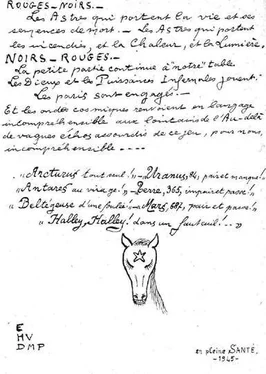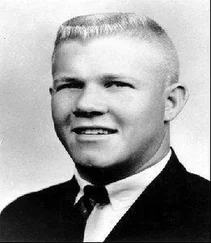Asked about the lack of communication from the Kneller family describing their safe arrival and establishment of a new home, Petiot said that they were ungrateful. This answer, however, did not address the question of why the Knellers had not contacted other family members.
Leser asked about the child.
“Yes,” Petiot said, “he was a delightful boy.”
“ ‘Was’ is the operative word,” Dupin said, noting that his pajamas were found at rue Le Sueur.
Floriot instructed his client not to respond.
“Those must be the pajamas that the kid slept in the last night,” Petiot answered anyway. Calm as usual, he proceeded to explain that the family did not want to begin their journey with “dirty laundry,” especially when it bore their initials. He always instructed his clients not to carry any identification papers and to remove anything from their personal belongings that might cast doubt on the forged documents. As for the pajamas, Petiot asked, “Why would I have kept them?”
Dupin stood and, as if he were finally about to trap Petiot as many expected, said that Petiot’s defense was “collapsing.” But he offered no major revelation or rebuttal. He only noted that Petiot refused to answer any question about the Kneller family.
“That’s false,” the defendant replied, claiming that he had answered many questions on the subject and only stopped when “they wanted to make me sign a list of answers to 362 questions that had not been asked.” To dramatic effect, he added, “I do not know if it is the habit of the justice to use such manners.”
Floriot tried to silence his client by shouting over him. Petiot was correct, he said. The prosecution had never provided him with any list of “what was allegedly found in the suitcases.”
At this point, Dupin interrupted, disputing the claim: “The juge d’instruction showed him the inventory several times. Petiot refused to answer.”
“Why do you only say such inexactitudes? Petiot never saw that inventory. Show me the interrogation in the dossier.… If you can provide me with that, I’ll immediately stop practicing law.”
Elissalde whispered something to Dupin, who then said that the juge d’instruction , Ferdinand Gollety, had confirmed that morning that Petiot had seen the inventory several times.
“Well, then call him to the stand.”
No one, Petiot repeated, had shown him the list or the suitcases. “You could have put anything in those suitcases.”
Petiot had a point. Strictly speaking, he was correct when he stated that the police did not provide him with a list of contents—they had offered , but he had refused on the grounds that the police had never shown him the suitcases themselves, let alone opened them to reveal the contents. The seals on the suitcases, moreover, had been placed on them at a later date and removed several times without his or his attorney’s presence. The contents had been handled by many investigators and even been exhibited to the public. Under the circumstances, Petiot had refused to sign any statement. Leser must have realized this, as he immediately called for a recess to evaluate the situation. The inventory of the suitcases was not discussed again.
THE first witnesses of the trial took the stand later that afternoon. The most effective one was Lucien Pinault, Massu’s successor and the commissaire in charge at the time of Petiot’s arrest. A broad-shouldered, heavily perspiring man who had, in the words of Pierre Bénard of France-Soir , the “face of a kindly boxer,” Pinault testified that he had conducted extensive interviews with Resistance fighters, and not a single one had known or recognized Dr. Petiot or his alias Dr. Eugène. The police officers who gave evidence after him, however, added little new information.
Day five opened on a rainy Friday, March 22. Professor Charles Sannié, the director of the Identité Judiciaire, Legal and Police Identification, at the Natural History Museum in Paris, described the physical evidence uncovered at Petiot’s town house. Jury and journalists alike listened intently, at least for the first part of the presentation. Many were restless because later that afternoon, the entire court would pack up, file into a long procession of cars outside the Palais de Justice, and reconvene at 21 rue Le Sueur. The “Circus Petiot” was going on tour.
René Floriot had proposed the temporary change of locale to demonstrate to the jury how much the police had distorted and exaggerated the claims about Petiot’s building, which, the defense maintained, was to be converted after the war into a medical clinic. True, Petiot had also used the property temporarily for his antiques business and for the headquarters of his Resistance organization, but it was hardly an “execution chamber,” as the newspapers during the Occupation reported and then embellished to distract a war-ridden city from its woes.
Before Professor Sannié could finish his testimony, several journalists left the courtroom, hoping to beat competitors to the remarkable photo opportunity of capturing the man accused of being France’s most deadly serial killer arriving at the scene of the crime. Rue Le Sueur was already filling up with spectators. Parisian newspapers had reported the day’s trip, complete with maps of the “chamber of horrors” in the middle of the elegant 16th arrondissement.
Rue Le Sueur had been blocked off from traffic, and Petiot’s building roped off from pedestrians. Two hundred policemen, using wooden barricades, would try to hold back the curious spectators pushing their way forward to a better view. Other people looked out from balconies or upper-story windows, or took their conversations about the “murder house” with its death pit and triangular chamber to nearby cafés and bistros.
Just before two p.m., as the rain continued to fall, Président Leser, the magistrates, Floriot, Dupin, and all the attorneys, assistants, and members of the jury descended the monumental front steps outside the Palais de Justice and filed into the fifteen cars waiting outside. An escort of police motorcyclists led the procession from Place Dauphine over the Pont-Neuf to the Quai du Louvre, the Quai des Tuileries, and then the Place de la Concorde. Avoiding the busy Champs-Élysées, the chauffeurs maneuvered through a number of streets on the Right Bank unil they reached the Étoile, Avenue Foch, and finally rue Le Sueur.
At the town house, a handcuffed Marcel Petiot stepped out of the black limousine, the fifth one in the procession, wearing his tweed overcoat with collar turned upward in the slight drizzle and smiling to the photographers. Two plainclothes police officers, with the brims of their felt hats turned down, were at his side, escorting him to the building. Taunts and jeers were heard from the crowd.
Président Leser, raising his hand, called the reassembled court to Petiot’s office. Judge, jury, prosecution, defense, civil parties, and the many relatives and spectators followed Professor Sannié into the room. No one, however, had thought to reconnect the electricity, and so the court met in the house of horrors by candlelight. “Truly enlightened justice,” Petiot quipped.
With the defendant appearing perfectly at ease, Sannié walked the members of the court through rooms of the mansion filled with what a Time correspondent described as “a strange conglomeration of expensive Louis XVI furniture, human bones, and 600 volumes of murder mysteries.” Pierre Scize of Le Figaro described the dilapidated building with knocked-over furniture and ripped-open divans as having “the leprous walls, the décor of a shady office, and the mezzanine of an abortionist drug trafficker.” Debris threatened to soil clothes. One person slipped on rat excrement. Many people thought that they could still smell human rot.
Читать дальше












